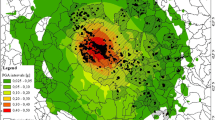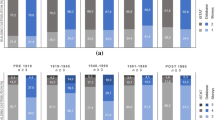Abstract
This paper illustrates the derivation of an empirical fragility model for residential unreinforced masonry (URM) buildings, calibrated on Italian post-earthquake damage data and compatible with the key features of the Italian national seismic risk platform. Seismic vulnerability is described by fragility functions for three vulnerability classes, then refined based on the building height. To this aim, a clustering strategy is implemented to merge predefined building typologies into vulnerability classes, based on the similarity of the observed seismic fragility. On the other side, a specific procedure is built up to determine the vulnerability composition of the exposed URM building stock, starting from national census data. The empirically-derived model was implemented into the national seismic risk platform and used, together with other vulnerability models, for assessing seismic risk in Italy. The results presented in this paper, consisting of refined typological fragility curves and fragility curves for vulnerability classes, can be also exploited for estimating both expected seismic damage and risk in sites with similar seismic hazard and building inventory.





Adapted from Michelini et al. (2008) and http://shakemap.rm.ingv.it/shake/index.html







Similar content being viewed by others
References
Ader T, Grant DN, Free M, Villani M, Lopez J, Spence R (2018) An unbiased estimation of empirical lognormal fragility functions with uncertainties on the ground motion intensity measure. J Earthq Eng. https://doi.org/10.1080/13632469.2018.1469439
Braga F., Dolce M., Liberatore D. (1982) A statistical study on damaged buildings and an ensuing review of the M.S.K.-76 scale. In: Proceedings of the 7th European conference on earthquale engineering, Athens, Greece
Census Data (2001) http://dawinci.istat.it/jsp/MD/dawinciMD.jsp
Charvet I, Ioannou I, Rossetto T, Suppasri A, Imamura F (2014) Empirical fragility assessment of buildings affected by the 2011 Great East Japan tsunami using improved statistical models. Nat Hazards 73(2):951–973
Chaulagain H, Rodrigues H, Silva V, Spacone E, Varum H (2015) Seismic risk assessment and hazard mapping in Nepal. Nat Hazards 78:583–602
Crowley H, Colombi M, Borzi B, Faravelli M, Onida M, Lopez M, Polli D, Meroni F, Pinho R (2009) A comparison of seismic risk maps for Italy. Bull Earthq Eng 7:149–180
Day WHE, Edelsbrunner H (1984) Efficient algorithms for agglomerative hierarchical clustering methods. J Classif 1(1):7–24
Del Gaudio C, De Martino G, Di Ludovico M, Manfredi G, Prota A, Ricci P, Verderame GM (2017) Empirical fragility curves from damage data on RC buildings after the 2009 L’Aquila earthquake. Bull Earthq Eng 15(4):1425–1450
Di Pasquale G, Orsini G, Romeo RW (2005) New developments in seismic risk assessment in Italy. Bull Earthq Eng 3:101–128
Dolce M, Goretti A (2015) Building damage assessment after the 2009 Abruzzi earthquake. Bull Earthq Eng 13(8):2241–2264
Dolce M, Masi A, Marino M, Vona M (2003) Earthquake damage scenarios of the building stock of Potenza (Southern Italy) including site effects. Bull Earthq Eng 1:115–140
Dolce M, Kappos A, Masi A, Penelis G, Vona M (2006) Vulnerability assessment and earthquake damage scenarios of the building stock of Potenza (Southern Italy) using Italian and Greek methodologies. Eng Struct 28:357–371
Dolce M, Speranza E, Giordano F, Borzi B, Bocchi F, Conte C, Di Meo A, Faravelli M, Pascale V (2019) Observed damage database of past Italian earthquakes: the DaDO WebGIS. Boll Geofis Teor Appl 60(2):141–164
Eleftheriadou AK, Karabinis AI (2013) Evaluation of damage probability matrices from observational seismic damage data. Earthq Struct 4(3):299–324
Eleftheriadou AK, Baltzopoulou AD, Karabinis AI (2016) Urban seismic risk assessment: statistical repair cost data and probable structural losses based on damage scenario-correlation analysis. Int J Adv Struct Eng 8(2):133–150
Erdik M, Aydinoglu N, Fahjan Y, Sesetyan K, Demircioglu M, Siyahi B, Durukal E, Ozbey C, Biro Y, Akman H, Yuzugullu O (2003) Earthquake risk assessment for Istanbul metropolitan area. Earthq Eng Eng Vibr 2(1):1–25
Faravelli M, Polli D, Quaroni D, Onida M, Pagano M, Di Meo A, Borzi B (2019) Italian platform for seismic risk and damage scenario evaluation. In: 7th ECCOMAS thematic conference on computational methods in structural dynamics and earthquake engineering, 24–26 June, Crete (Greece)
Goretti A, Di Pasquale G (2004) Building inspection and damage data for the 2002 Molise, Italy, earthquake. Earthq Spectra 20(S1):S167–S190
Grünthal G (ed.), Musson RMW, Schwarz J, Stucchi M (1998) European Macroseismic Scale. Cahiers du Centre Européen de Géodynamique et de Séismologie, Vol 15-European Macroseismic Scale 1998. European Centre for Geodynamics and Seismology, Luxembourg
Ioannou I, Bessason B, Kosmidis I, Bjarnason JO, Rossetto T (2018) Empirical seismic vulnerability assessment of Icelandic buildings affected by the 2000 sequence of earthquakes. Bull Earthq Eng 16:5875–5903
Karababa FS, Pomonis A (2011) Damage data analysis and vulnerability estimation following the August 14, 2003 Lefkada Island, Greece, Earthquake. Bull Earthq Eng 9:1015–1046
Lagomarsino S, Giovinazzi S (2006) Macroseismic and mechanical models for the vulnerability and damage assessment of current buildings. Bull Earthq Eng 4:415–443
Lallemant D, Kiremidjian A, Burton H (2015) Statistical procedures for developing earthquake damage fragility curves. Earthq Eng Struct Dyn 44:1373–1389
Lucantoni A, Bosi V, Bramerini F, De Marco R, Lo PT, Naso G, Sabetta F (2001) Seismic risk in Italy. Ing Sismica, XVII 1:5–36 (in Italian)
Marulanda SMC, Carreño ML, Cardona OD, Ordaz MG, Barbat AH (2013) Probabilistic earthquake risk assessment using CAPRA: application to the city of Barcelona. Nat Hazards 69:59–84
Michelini A, Faenza L, Lauciani V, Malagnini L (2008) ShakeMap implementation in Italy. Seismol Res Lett 79(5):688–697
Mouroux P, Le Brun B (2006) Presentation of the RISK-UE Project. Bull Earthq Eng 4(4):323–339
National Department of Civil Protection (NDCP, ed., 2018) National risk assessment: overview of the potential major disasters in Italy http://www.protezionecivile.gov.it/documents/20182/823803/Documento+sulla+Valutazione+nazionale+dei+rischi/57f337fd-a421-4cb0-b04c-234b61997a2f
Pagani M, Monelli D, Weatherill G, Danciu L, Crowley H, Silva V, Henshaw P, Butler L, Nastasi M, Panzeri L, Simionato M, Vigano D (2014) Openquake engine: an open hazard (and risk) software for the global earthquake model. Seismol Res Lett 85(3):692–702
Rossetto T, Elnashai A (2003) Derivation of vulnerability functions for European-type RC structures based on observational data. Eng Struct 25(10):1241–1263
Rossetto T, Ioannou I, Grant DN (2013) Existing empirical vulnerability and fragility functions: Compendium and guide for selection. GEM Technical Report 2013-X, GEM Foundation, Pavia, Italy
Rosti A, Rota M (2017) Comparison of PSH results with historical macroseismic observations at different scales. Part 2: application to South-East France. Bull Earthq Eng 15(11):4609–4633
Rosti A, Rota M, Penna A (2018) Damage classification and derivation of damage probability matrices from L’Aquila (2009) post-earthquake survey data. Bull Earthq Eng 16(9):3687–3720
Rosti A, Rota M, Penna A (2020) Influence of seismic input characterisation on empirical damage probability matrices for the 2009 L’Aquila event. Soil Dyn Earthq Eng 128:105870. https://doi.org/10.1016/j.soildyn.2019.105870
Rota M, Rosti A (2017) Comparison of PSH results with historical macroseismic observations at different scales. Part 1: methodology. Bull Earthq Eng 15(11):4585–4607
Rota M, Penna A, Strobbia CL (2008) Processing Italian damage data to derive typological fragility curves. Soil Dyn Earthq Eng 28(10):933–947
Rota M, Penna A, Strobbia C, Magenes G (2011) Typological seismic risk maps for Italy. Earthq Spectra 27(3):907–926
Sabetta F, Goretti A, Lucantoni A (1998) Empirical fragility curves from damage surveys and estimated strong ground motion. In: Proceedings of the 11th European conference earthquake engineering, Balkema, Rotterdam
Silva V, Crowley H, Varum H, Pinho R (2015) Seismic risk assessment for mainland Portugal. Bull Earthq Eng 13(2):429–457
Silva V, Amo-Oduro D, Calderon A, Dabbeek J, Despotaki V, Martins L, Rao A, Simionato M, Viganò D, Yepes-Estrada C, Acevedo A, Crowley H, Horspool N, Jaiswal K, Journeay M, Pittore M (2018) Global Earthquake Model (GEM). Seismic Risk Map (version 2018.1), https://doi.org/10.13117/gemglobal-seismic-risk-map-2018
Smerzini C, Pitilakis K (2018) Seismic risk assessment at urban scale from 3D physics-based numerical modelling: the case of Thessaloniki. Bull Earthq Eng 16:2609–2631
Stucchi M, Akinci A, Faccioli E, Gasperini P, Malagnini L, Meletti C, Montaldo V, Valensise G, (2004) Mappa di Pericolosità sismica del territorio Nazionale http://zonesismiche.mi.ingv.it/documenti/rapporto_conclusivo.pdf (in Italian)
Stucchi M, Meletti C, Montaldo V, Crowley H, Calvi GM, Boschi E (2011) Seismic hazard assessment (2003–2009) for the Italian building code. B Seismol Soc Am 101:1885–1911
Tyagunov S, Grünthal G, Wahlström R, Stempniewski L, Zschau J (2006) Seismic risk mapping for Germany. Nat Hazards Earth Syst 6:573–586
Vicente R, Parodi S, Lagomarsino S, Varum H, Mendes Silve JAR (2011) Seismic vulnerability and risk assessment: case study of the historic city centre of Coimbra, Portugal. Bull Earthq Eng 9:1067–1096
Wald DJ, Worden CB, Quitoriano V, Pankow KL (2006) ShakeMap® manual, technical manual, users guide, and sofware guide. http://pubs.usgs.gov/tm/2005/12A01/pdf/508TM12-A1.pdf
Acknowledgements
This work was developed under the financial support of the Italian Department of Civil Protection, within the ReLUIS-DPC 2018 Research Project, which is gratefully acknowledged.
Author information
Authors and Affiliations
Corresponding author
Additional information
Publisher's Note
Springer Nature remains neutral with regard to jurisdictional claims in published maps and institutional affiliations.
Rights and permissions
About this article
Cite this article
Rosti, A., Rota, M. & Penna, A. Empirical fragility curves for Italian URM buildings. Bull Earthquake Eng 19, 3057–3076 (2021). https://doi.org/10.1007/s10518-020-00845-9
Received:
Accepted:
Published:
Issue Date:
DOI: https://doi.org/10.1007/s10518-020-00845-9




